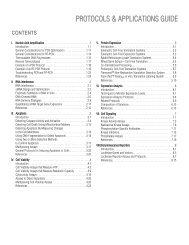Cloning Protocols and Applications Guide-A4 format - Promega
Cloning Protocols and Applications Guide-A4 format - Promega
Cloning Protocols and Applications Guide-A4 format - Promega
You also want an ePaper? Increase the reach of your titles
YUMPU automatically turns print PDFs into web optimized ePapers that Google loves.
||||||||||||| 13<strong>Cloning</strong><br />
addition of rhamnose to the medium, <strong>and</strong> provides precise<br />
control of T7 RNA polymerase abundance <strong>and</strong> thereby<br />
precise control of recombinant protein production.<br />
Additional Resources for Single Step (KRX) Competent<br />
Cells<br />
Technical Bulletins <strong>and</strong> Manuals<br />
TB352 Single Step (KRX) Competent Cells Technical<br />
Bulletin<br />
<strong>Promega</strong> Publications<br />
15N protein labeling using Escherichia coli strain KRX<br />
Compatibility of Single Step (KRX) Competent Cells with<br />
the MagneGST Pull-Down System<br />
The Single Step (KRX) Competent Cells: Efficient cloning<br />
<strong>and</strong> high protein yields<br />
Citations<br />
Semenova, E. et al. (2011) Interference by clustered regularly<br />
interspaced short palindromic repeat (CRISPR) RNA is<br />
governed by a seed sequence. Proc. Natl. Acad. Sci. USA<br />
108, 10098–103.<br />
KRX E. coli cells carrying three plasmids that expressed<br />
Cascade, Cas3 <strong>and</strong> J3 pre-crRNA were grown in LB medium<br />
with antibiotics until reaching an O.D.600 of ~0.3. Then the<br />
cells were induced with 1mM IPTG <strong>and</strong> 0.2% L-arabinose<br />
<strong>and</strong> grown for 45 minutes. The cells were washed twice<br />
with ice-cold water to render them electrocompetent, then<br />
transformed with a r<strong>and</strong>om mutant library of 350bp λ<br />
phage fragments cloned into pUC19. Colonies that escaped<br />
the CRISPR (clustered regularly interspaced short<br />
palindromic repeats)/Cas system were grown <strong>and</strong> the<br />
plasmids sequenced to identify point mutations that<br />
allowed escape.<br />
PubMed Number: 21646539<br />
Kim, K.K. et al. (2011) Fox-3 <strong>and</strong> PSF interact to activate<br />
neural cell-specific alternative splicing. Nucleic Acids Res.<br />
39, 3064–78.<br />
GST–Fox-3 fusion proteins were expressed in KRX E. coli<br />
cells <strong>and</strong> captured on glutathione sepharose beads.<br />
Myc-tagged polypyrimidine tract binding-associated<br />
splicing factor (PSF) <strong>and</strong> non-POU domain-containing<br />
octamer-binding protein (NonO) constructs were<br />
transcribed <strong>and</strong> translated using the TNT® Coupled<br />
Reticulocyte Lysate System. The cell-free expressed proteins<br />
were mixed with the GST-Fox-3 fusion proteins bound to<br />
beads <strong>and</strong> incubated for 1 hour in a pull-down assay. SDS<br />
sample buffer denatured the protein complexes prior to<br />
SDS-PAGE separation. These gels were stained with<br />
Coomassie® blue or analyzed by immunoblotting.<br />
PubMed Number: 21177649<br />
HB101 Competent Cells<br />
HB101 Competent Cells (Cat.# L2011) are prepared<br />
according to a modified procedure of Hanahan, 1985. HB101<br />
cells (Yanisch-Perron et al. 1985) are useful for cloning with<br />
vectors that do not require α-complementation for<br />
blue/white screening.<br />
<strong>Protocols</strong> & <strong>Applications</strong> <strong>Guide</strong><br />
www.promega.com<br />
rev. 1/12<br />
Additional Resources for HB101 Competent Cells<br />
Technical Bulletins <strong>and</strong> Manuals<br />
TB095 E. coli Competent Cells Technical Bulletin<br />
III. PCR <strong>Cloning</strong> <strong>Protocols</strong><br />
A. Ligation <strong>and</strong> Trans<strong>format</strong>ion<br />
Materials Required:<br />
(see Composition of Solutions section)<br />
• PCR product (has an A overhang; purification is<br />
optional) or blunt DNA fragment with an A residue<br />
added<br />
• pGEM®-T Easy Vector System (Cat.# A1380) or<br />
pGEM®-T Easy Vector System (Cat.# A3610)<br />
Both systems include T4 DNA Ligase <strong>and</strong> chemically<br />
competent high-efficiency JM109 cells.<br />
• Nuclease-Free Water (Cat.# P1193)<br />
• Optional: 4°C water bath<br />
• LB-Ampicillin plates containing X-Gal <strong>and</strong> IPTG<br />
• high-efficiency competent cells [e.g., JM109 Competent<br />
Cells (Cat.# L2001) or Single Step KRX Competent Cells<br />
(Cat.# L3002)], if needed<br />
• SOC medium<br />
• 42°C water bath<br />
• ice<br />
Vector:Insert Ratio<br />
After the insert DNA is prepared for ligation, estimate the<br />
concentration by comparing the staining intensity with that<br />
of DNA molecular weight st<strong>and</strong>ard of similar size <strong>and</strong><br />
known concentrations on an ethidium bromide-stained<br />
agarose gel. If the vector DNA concentration is unknown,<br />
estimate the vector concentration by the same method. Test<br />
various vector:insert DNA ratios to determine the optimal<br />
ratio for a particular vector <strong>and</strong> insert. In most cases, a 1:1<br />
or 1:3 molar ratio of vector:insert works well. The following<br />
example illustrates the calculation of the amount of insert<br />
required at a specific molar ratio of vector:insert.<br />
[(ng of vector × kb size of insert) ÷ kb size of vector] × (molar<br />
amount of insert ÷ molar amount of vector) = ng of insert<br />
Example:<br />
How much 500bp insert DNA needs to be added to 100ng<br />
of 3.0kb vector in a ligation reaction for a desired<br />
vector:insert ratio of 1:3?<br />
[(100ng vector × 0.5kb insert) ÷ 3.0kb vector] × (3 ÷ 1) = 50ng<br />
insert<br />
PROTOCOLS & APPLICATIONS GUIDE 13-10

















